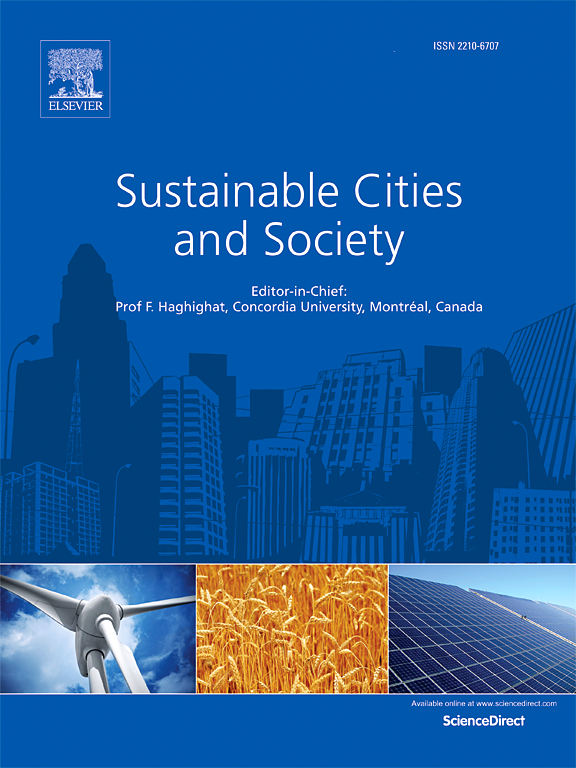德黑兰城市热岛缓解:基于区域的制图和关键驱动因素分析
IF 10.5
1区 工程技术
Q1 CONSTRUCTION & BUILDING TECHNOLOGY
引用次数: 0
摘要
城市热岛(UHIs)导致城市温度高于农村地区,增加了用于冷却的能源消耗,降低了空气质量,并加剧了与热有关的健康问题。尽管以前的研究已经探索了德黑兰的UHIs,但仍然缺乏全面的分析。本研究采用宏观尺度的方法,结合线性、非线性和基于地理位置的方法,详细探讨了影响热岛强度的关键因素。它使用遥感和机器学习通过检查GIS中的地表温度和土地覆盖数据来分析德黑兰的UHIs。该研究比较了城市与周边农村地区的温度,并通过普通最小二乘(OLS)、随机森林(RF)和地理加权回归确定了影响UHIs的关键因素。研究结果显示,德黑兰各地的UHII差异很大,与农村地区相比,中心地区的温差超过5°C。OLS模型确定气溶胶光学深度(0.38)、人口密度(0.45)和归一化差异建筑指数(NDBI)(0.17)是高UHII的贡献者,而相对湿度(-0.51)和地形坡度(-0.22)与低UHII有关。该模型的均方误差为0.33,r平方值为0.84,强调人口密度、相对湿度和NDBI是影响UHII的主要因素。研究结果可以为规划和设计战略提供信息,以促进气候变化适应和增强城市韧性。本文章由计算机程序翻译,如有差异,请以英文原文为准。
Urban heat island mitigation in Tehran: District-based mapping and analysis of key drivers
Urban Heat Islands (UHIs) result in higher urban temperatures than rural areas, increasing energy use for cooling, degrading air quality, and worsening heat-related health issues. Although previous studies have explored UHIs in Tehran, a comprehensive analysis remains lacking. This study adopts a macro-scale approach, combining linear, non-linear, and location-based methods to investigate key factors influencing UHI intensity (UHII) in detail. It uses remote sensing and machine learning to analyze UHIs in Tehran by examining Land Surface Temperature and Land Cover data within GIS. The study compares urban temperatures with those in surrounding rural areas and identifies key factors influencing UHIs through ordinary least squares (OLS), random forest (RF), and geographically weighted regression. The findings reveal substantial UHII variations across Tehran, with central districts showing temperature differences greater than 5 °C compared to rural areas. The OLS model identifies aerosol optical depth (0.38), population density (0.45), and Normalized Difference Built-up Index (NDBI) (0.17) as contributors to higher UHII, while relative humidity (-0.51) and terrain slope (-0.22) are linked to lower UHII. The RF model, with a Mean Squared Error of 0.33 and an R-squared value of 0.84, highlights population density, relative humidity, and NDBI as primary factors influencing UHII. Results can inform planning and design strategies to foster climate change adaptation and enhance urban resilience.
求助全文
通过发布文献求助,成功后即可免费获取论文全文。
去求助
来源期刊

Sustainable Cities and Society
Social Sciences-Geography, Planning and Development
CiteScore
22.00
自引率
13.70%
发文量
810
审稿时长
27 days
期刊介绍:
Sustainable Cities and Society (SCS) is an international journal that focuses on fundamental and applied research to promote environmentally sustainable and socially resilient cities. The journal welcomes cross-cutting, multi-disciplinary research in various areas, including:
1. Smart cities and resilient environments;
2. Alternative/clean energy sources, energy distribution, distributed energy generation, and energy demand reduction/management;
3. Monitoring and improving air quality in built environment and cities (e.g., healthy built environment and air quality management);
4. Energy efficient, low/zero carbon, and green buildings/communities;
5. Climate change mitigation and adaptation in urban environments;
6. Green infrastructure and BMPs;
7. Environmental Footprint accounting and management;
8. Urban agriculture and forestry;
9. ICT, smart grid and intelligent infrastructure;
10. Urban design/planning, regulations, legislation, certification, economics, and policy;
11. Social aspects, impacts and resiliency of cities;
12. Behavior monitoring, analysis and change within urban communities;
13. Health monitoring and improvement;
14. Nexus issues related to sustainable cities and societies;
15. Smart city governance;
16. Decision Support Systems for trade-off and uncertainty analysis for improved management of cities and society;
17. Big data, machine learning, and artificial intelligence applications and case studies;
18. Critical infrastructure protection, including security, privacy, forensics, and reliability issues of cyber-physical systems.
19. Water footprint reduction and urban water distribution, harvesting, treatment, reuse and management;
20. Waste reduction and recycling;
21. Wastewater collection, treatment and recycling;
22. Smart, clean and healthy transportation systems and infrastructure;
 求助内容:
求助内容: 应助结果提醒方式:
应助结果提醒方式:


